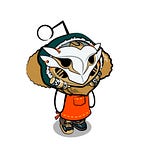The graph Network
Explaining The Graph and how it is integrated with Web3
Mar 12
Today’s article is going to explore The Graph, a network that provides indexing protocols for blockchain
It provides a way to search data that is stored in ledger quickly without having centralization.
What is indexing?!
Before we can get what exactly the graph does it is important to understand the concept of indexing.
Lets go,
When you have a large database ie blockchain ledger, It can be time consuming to search through the data to find the transaction you are looking for.
For example, Imagine for a specific transaction but have no idea which block it was mined in, with indexing this is quite easy since index has all transaction hashes paired up with what block they were mined in
So what The Graph does is to provide indexing services in a decentralized way unlike traditional blockchain explorers such as Bsc scan, the traditional sites also called ingestion sites they ingest data from ledger to store in database are a centralized point made difficult to create truly DAPPS
To add up,
The graph has created its own query language GraphQL which allows to specify field interests in having indexed and search criteria you want applied.
This is stored in subgraps for example,Uniswap subgraph…,
For The Graph network is made up of different parts which work together to make the system
. • The Indexers.These are the people providing the indexing services, as well as running the nodes. They stake The Graph (GRT) tokens in order to become Indexers. They are responsible for providing the indexing that the sub-graphs are looking to have indexed, and earn rewards for doing so.
. • The Consumers are the users of the network, be them end users or a Decentralized Application (DApp). They will query the sub-graphs from the Indexers, and pay the fees for the services.
. •The curators use The Graph (GRT) tokens to signal which sub-graphs they believe are worth being indexed. These can be either just end users who believe the sub-graph is worth indexing, or developers that want to help ensure theirs is being indexed.
. •Delegators on the network stake their The Graph (GRT) tokens with the Indexers, and they will earn a portion of the rewards and fees collected by them. They get a portion of the benefit of the Indexers, while not having to operate their own node.
. •The final participants are the Fishermen and Arbitrators, who are responsible to resolve disputes when situations arise such as when an Indexer provides incorrect data.
The Graph integration with Web3 space
The backers of The Graph protocol, that aims at making on chain data more accessible launched funds to support developers building the system
Through multicoin capital, reciprocal ventures, Gumi crypto capital, NGC ventures, Coindesk parents, Digital currency and HashKey announced $205 million pot
The fund will provide grants to teams building DAPPS using the Graph querying technology spanning sector as diverse as DeFi, non fungible token(NFT), Decentralized autonomous organisation(DAO), market places, cross chain infrastructure and metaverse ,, A shared interactive and potentially immersive digital environment
Whether consumers are onboard with Web3 or not. Web3 is making its way to us, DengChao managing director of hashkey capital said in a statement, Developers need decentralized web3 solutions like the Graph that are designed to be accessible.
